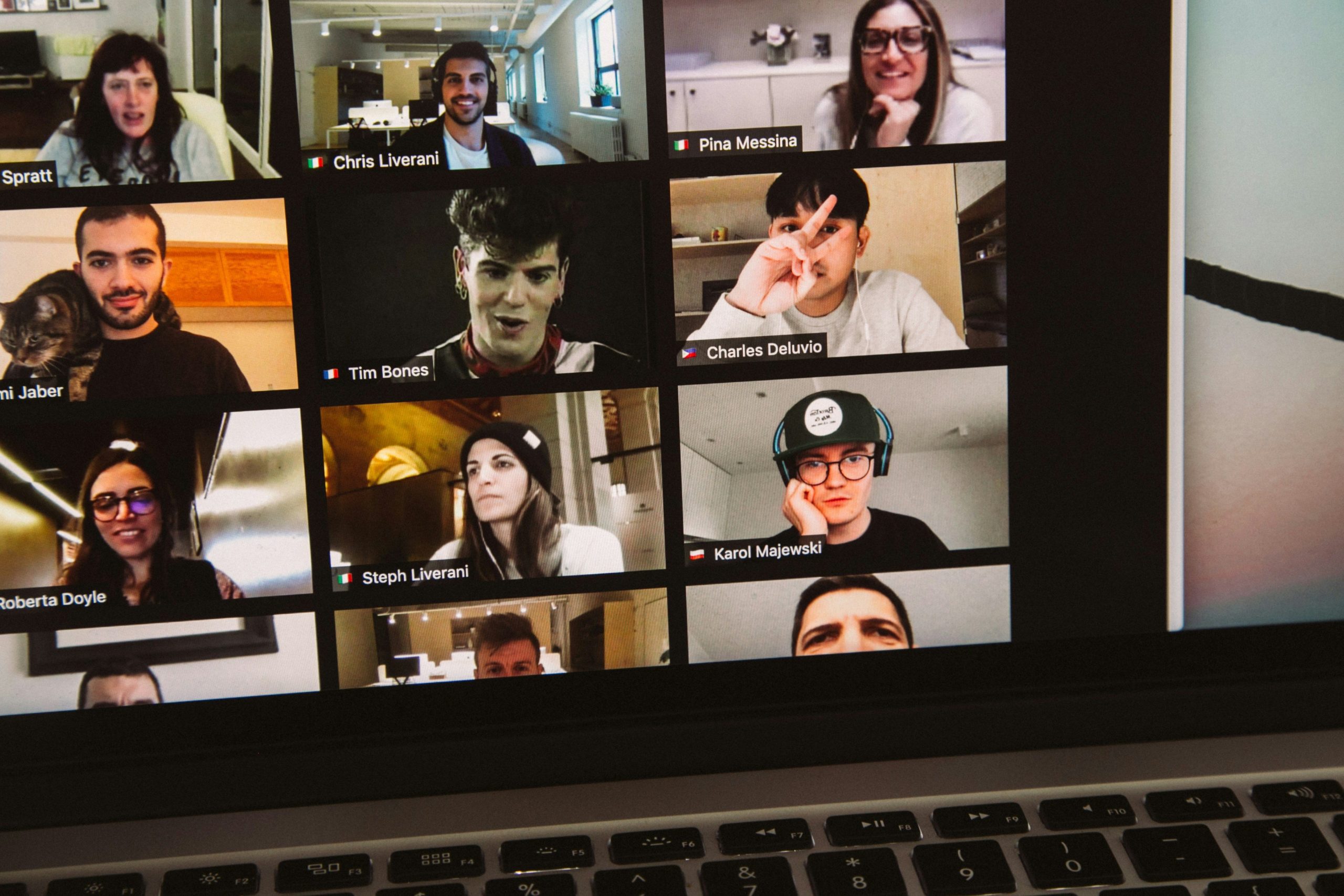As the digital workspace continues to expand, the art of team building has taken a creative virtual turn.
Gone are the days of water cooler chats and shared lunches, leaving remote teams searching for new ways to connect and collaborate.
Virtual team-building activities have emerged as a dynamic solution, offering everything from online office games to virtual happy hours. All designed to foster communication, boost morale, and strengthen relationships within remote teams.
Dive into the world of virtual team building with our comprehensive guide, exploring a range of activities that promise to bring your remote team together, no matter where they are in the world.
The Rise of Virtual Team Building in Remote Work
The transition to remote work has been significant, with many employees now operating from home offices or other remote locations. This shift has introduced challenges in maintaining team cohesion, as traditional in-person team-building activities are no longer feasible. Without the casual interactions that occur naturally in a physical office, such as impromptu meetings or lunchtime conversations, teams can struggle to develop strong bonds and a sense of unity.
The absence of face-to-face communication can lead to feelings of isolation and a disconnect among team members. This can have a detrimental effect on team dynamics, making it harder to build trust and collaborate effectively. The challenges include:
- Limited opportunities for spontaneous interaction
- Difficulty in establishing rapport and understanding non-verbal cues
- Managing different time zones which can complicate scheduling
In response to these challenges, virtual team building has emerged as a crucial strategy for fostering team spirit and collaboration. These activities are designed to bridge the physical gap, using technology to create shared experiences. Virtual team building can take many forms, from online games and challenges to group workshops and virtual happy hours, all aimed at enhancing communication and teamwork.
The rise of virtual team building is not just a temporary fix but is becoming an integral part of remote work culture. Companies are recognizing the importance of these activities in:
- Improving team communication and efficiency
- Helping new team members integrate smoothly
- Providing a platform for creative problem-solving
As the workforce continues to adapt to remote working conditions, virtual team building activities are proving to be more than just a trend. They are essential tools that help maintain a positive and productive work environment, even when team members are miles apart. The ability to overcome the challenges of remote work through virtual team building is a testament to the resilience and adaptability of modern teams.
Key Benefits of Virtual Team Building for Remote Teams
Virtual team building is more than just a way to have fun with colleagues online; it serves as a critical component in maintaining a healthy and productive remote work environment. For remote teams, these activities are essential in fostering a sense of community and belonging, which can be challenging to achieve through screens. By participating in virtual team building, employees can feel more connected to their colleagues, which translates into a more cohesive team dynamic.
One of the key benefits of virtual team building is the boost in productivity it brings. When team members feel connected and engaged, they are more likely to collaborate effectively and contribute their best work. This is particularly important in a remote setting where the lack of physical presence can sometimes lead to disengagement. Virtual team building activities help to:
- Encourage clear communication
- Align team members with organizational goals
- Create a shared sense of purpose
Stronger relationships among team members is another significant advantage of virtual team building. Through a variety of activities, colleagues can get to know each other on a more personal level, which helps to build trust and understanding. This is crucial for a remote team’s success, as it:
- Reduces the potential for conflict
- Facilitates better problem-solving
- Encourages a supportive work culture
Virtual team building also contributes to employee morale. In a remote setting, where isolation can be a real issue, these activities provide a welcome break from the routine and an opportunity to recharge. They offer a platform for employees to feel recognized and valued, which can significantly enhance job satisfaction. When employees are happy, they tend to be more motivated and loyal to the company.
Lastly, virtual team building is not bound by geographical constraints, allowing for diverse and inclusive teams to thrive. It enables people from different locations and cultures to come together, share experiences, and learn from one another. This diversity can lead to more innovative solutions and a broader perspective on projects. Ultimately, virtual team building is a powerful tool for remote teams, fostering productivity, strong relationships, high morale, and a culture of inclusivity.
Virtual Icebreakers to Kickstart Team Engagement

Starting a virtual meeting with the right tone is crucial for team engagement. Virtual icebreakers are the perfect tool for this job. They help to ease participants into the meeting, setting a friendly atmosphere right from the start. These activities are designed to be quick and enjoyable, providing a moment of relaxation before diving into the more serious agenda items.
One simple yet effective icebreaker is the “Two Truths and a Lie” game. Each team member presents two true statements and one false statement about themselves, and the rest of the team tries to guess which one is the lie. This game is not only fun but also helps team members learn interesting facts about each other, fostering a deeper connection.
For teams that enjoy a bit of competition, a virtual scavenger hunt can be incredibly engaging. Here’s how it works:
- Give team members a list of items to find within their home or office space.
- Set a time limit for everyone to find the items and show them on camera.
- The first person or team to collect all items wins a small prize or bragging rights.
If you’re looking to encourage creativity, “Online Pictionary” is a great choice. Participants take turns drawing something related to work or a random topic, while others guess what it is. This not only breaks the ice but also gets those creative juices flowing, which can be beneficial for the brainstorming sessions that may follow.
For a more thought-provoking start, “Pair & Share” can be an excellent option. Team members are paired up randomly and given a topic to discuss for a few minutes in breakout rooms. Afterward, they share insights or fun facts from their discussion with the larger group. This encourages more intimate conversation and can be especially comfortable for introverts.
Lastly, online icebreaker questions are a quick and easy way to get everyone talking. You can use questions like “What’s your favorite work-from-home snack?” or “Show us your pet or a favorite item on your desk.” These questions are not only fun but also add a personal touch to the meeting, making team members feel more connected despite the distance.
Collaboration-Boosting Virtual Activities

Collaboration is the backbone of any successful remote team, and virtual activities specifically designed to enhance this skill can make a significant difference. Collaboration-boosting activities help team members navigate the complexities of working together from a distance, improving their ability to tackle problems and innovate. These activities often require a collective effort to achieve a common goal, which can translate into better teamwork during work projects.
One effective activity for fostering collaboration is the “Virtual Escape Room” challenge. Teams are locked in a virtual room and must solve puzzles and find clues to escape. This requires team members to:
- Communicate clearly
- Share ideas and solutions
- Work under pressure as a cohesive unit
Another activity that encourages teamwork is the “Online Office Olympics”. This can include a series of short, fun competitions that teams participate in via video call. Examples of games might be:
- Desk chair races
- Speed typing contests
- Creative photo challenges
For teams that thrive on creativity, “Build Your Virtual City” is an innovative activity. Team members collaborate to design and plan a city using online tools or a shared document. This activity demands a high level of collaboration as each member contributes to:
- The city’s layout
- Architectural design
- Functional infrastructure
“Idea Marathon” is another collaborative activity where team members generate as many ideas as possible related to a given problem or project within a set time frame. This brainstorming session can be structured with rules such as:
- No idea is too outlandish
- Building on each other’s suggestions
- Encouraging a non-judgmental environment
Lastly, “Chain Reaction” is a virtual activity where team members must create a sequence of events that build on each other, similar to a Rube Goldberg machine. This activity requires precise communication and coordination, as each member’s input directly affects the next step in the chain. The success of the activity relies on the team’s ability to:
- Strategize together
- Anticipate the consequences of each action
- Trust in each other’s execution
Fun Virtual Activities to Elevate Team Morale
Keeping team morale high is essential, especially when everyone is working remotely and might feel disconnected. Fun virtual activities can be the perfect remedy, adding a dash of excitement and laughter to the daily grind. These activities not only break the monotony but also help team members feel more connected and valued.
A popular choice for a fun activity is a virtual movie night. Teams can pick a movie, stream it simultaneously, and chat about the plot or their favorite scenes in real-time. This can recreate the feeling of a group outing without anyone having to leave their home. It’s a simple yet effective way to share an experience and create common ground for future conversations.
Here are a few more activities that can lighten the mood:
- Online karaoke sessions where team members can showcase their singing talents or just have a good laugh
- Virtual costume parties themed around holidays or favorite movie characters, adding a visual element of fun to regular video calls
- Digital board game nights with games that are available online, allowing for friendly competition and strategy
For those teams that enjoy a bit of creativity, virtual arts and crafts sessions can be a hit. Team members can follow along with an online class or tutorial to create something unique, which they can then share with the group. This not only encourages creativity but also gives everyone a tangible reminder of their team’s togetherness.
Another activity that’s sure to bring smiles is a virtual pet show-and-tell. Employees can introduce their pets on a video call, share funny stories, and even have a ‘cutest pet’ contest. It’s a heartwarming way to learn more about each other’s lives outside of work and build stronger personal connections.
Lastly, don’t underestimate the power of virtual trivia nights. With a variety of themes and difficulty levels, trivia can challenge team members’ knowledge and provoke lively discussions. Plus, it’s an excellent opportunity for team members to collaboratively showcase their expertise in different areas, from pop culture to history.
Competitive Virtual Team Activities for a Healthy Rivalry

Competitive virtual team activities can be a thrilling way to inject some healthy rivalry into remote work environments. These activities not only enhance engagement but also encourage teams to push their boundaries in a fun and supportive setting. Whether it’s a battle of wits or a test of speed, these competitions can lead to greater camaraderie and a stronger team spirit.
One engaging competitive activity is the Virtual Trivia Challenge. Team members can be divided into groups and face off in a series of trivia rounds that cover various topics. This can include:
- Company-related questions
- General knowledge
- Pop culture references
The group with the highest score at the end of the game is crowned the trivia champions, fostering a sense of accomplishment and unity.
Another popular competitive activity is the Online Coding Contest for teams with a knack for technology. Participants are given a problem to solve within a limited time frame, and the fastest coder with the most efficient solution wins. This type of competition can:
- Sharpen technical skills
- Promote innovative thinking
- Provide a platform for showcasing talent
For teams that enjoy creative challenges, Design Hackathons can be organized virtually. Team members collaborate to come up with design solutions for a given scenario, and then pitch their ideas to a panel of judges. The winning design is often recognized with a prize, and the activity can:
- Enhance collaboration
- Boost creative problem-solving abilities
- Highlight individual team members’ design skills
Virtual Sales Pitches are an excellent way for teams in sales or marketing to engage in friendly competition. Participants can develop and present their best sales strategies for a product or service, with the rest of the team acting as potential clients. This activity helps to:
- Refine persuasive communication skills
- Foster strategic thinking
- Encourage learning from each other’s techniques
Lastly, a Remote Photography Contest can bring out the competitive spirit in a more relaxed manner. Team members can submit photos based on a theme, and everyone votes for their favorites. This not only allows for a display of creativity but also gives a glimpse into each other’s perspectives, enhancing team bonding and understanding.
Integrating Team Building into Virtual Meetings

Integrating team building into virtual meetings is a strategic approach to enhance engagement and strengthen connections among remote team members. By embedding simple, yet effective activities into regular meetings, you can transform routine check-ins into dynamic interaction sessions. This not only breaks the ice but also reinforces team cohesion, making every virtual encounter an opportunity for team growth.
Start with icebreaker questions that are relevant to the meeting’s agenda or theme. These should be light-hearted and easy to answer, prompting everyone to contribute. For example, if the meeting is about project planning, you might ask, “What’s one skill you’d like to develop during this project?” This encourages personal investment and gets team members thinking about their role in a bigger picture.
Incorporate mini-challenges that can be completed within the meeting timeframe. These could include:
- A quick problem-solving puzzle related to the work at hand.
- A creative storytelling round where each person builds on a story related to the team’s project.
- A virtual brainstorm where everyone submits an idea and votes on the best one.
These activities foster collaboration and quick thinking, which are valuable skills in any remote team.
For longer meetings, include a short team-building exercise midway as a break. This could be a virtual team stretch, a 5-minute meditation session, or a group breathing exercise. Not only does this offer a mental reset, but it also shows a commitment to team well-being, which is crucial for remote workers.
End meetings on a positive note with a quick round of appreciation, where team members can acknowledge each other’s contributions or share something they learned. This practice builds a culture of gratitude and recognition, which can significantly boost morale and leave team members feeling valued and connected.
Educational Virtual Team Activities for Skill Building
Educational virtual team activities go beyond just having fun; they’re about growing together as a team. By blending learning with interactive experiences, these activities help team members develop new skills and share knowledge in a way that’s both engaging and beneficial for their professional growth.
A popular educational activity is the ‘Show and Learn’ session, where team members take turns presenting a skill or topic they’re passionate about. This can range from a new software tool to a personal productivity hack. It’s a fantastic way for team members to:
- Learn from each other’s expertise
- Discover hidden talents within the team
- Foster a culture of continuous learning
Virtual workshops are another great way to build skills within a remote team. These can be tailored to the team’s needs and can cover a variety of topics, such as:
- Leadership development
- Technical skills training
Creative thinking and innovation Workshops can be led by internal experts or outside professionals, providing a structured learning experience.
Online trivia games can be both fun and educational. They’re an excellent way to test and expand the team’s knowledge on a wide array of subjects. To make it more relevant, consider:
- Including questions related to your industry
- Creating a themed trivia around skills the team is looking to develop
- Offering small rewards to encourage competitive learning
For teams looking to dive deeper into industry-specific knowledge, a work-related podcast club can be insightful. Team members can listen to selected podcasts and then come together to discuss:
- Key takeaways and insights
- How the topics can be applied to their work
- New ideas sparked by the podcast content
Lastly, hosting a series of guest speaker events can bring new perspectives and expert knowledge to the team. These can be conducted virtually with industry leaders or motivational speakers discussing topics such as:
- Emerging industry trends
- Success stories and case studies
- Personal development and career growth
This not only broadens the team’s knowledge but also keeps them inspired and forward-thinking.
Wellness-Focused Virtual Activities for Remote Teams

Remote teams face unique challenges that can impact their physical and mental well-being, such as the lack of separation between work and personal life, which can lead to burnout. To combat these issues, it’s crucial to integrate wellness-focused virtual activities into team building. These activities not only promote health but also enhance team cohesion by encouraging members to support each other’s well-being.
Virtual yoga sessions are a fantastic way to start. They help in reducing stress and improving flexibility, which is beneficial for those sitting for long hours. Yoga sessions can be scheduled before work hours to energize the team or after hours to help them unwind. Similarly, guided meditation can offer mental clarity and a sense of calm, which is essential in a fast-paced work environment.
Here are a couple of more structured wellness activities:
- Monthly mental health workshops provide techniques for balancing work and personal life.
- Stress-management training teaches employees how to handle work-related stress effectively.
Activities that foster social connections can also contribute to overall wellness. Virtual book clubs encourage learning and discussion, while remote coworking hours help combat feelings of isolation by providing a space for casual interaction. These activities can be easily organized and have the added benefit of building a supportive community within the team.
Lastly, health and wellness education events with expert speakers can empower employees with knowledge to improve their daily routines. Whether it’s nutritional advice, exercise tips, or strategies for better sleep, these sessions can make a significant difference in the team’s overall health. Integrating these wellness-focused virtual activities can lead to a happier, healthier, and more cohesive remote team.
A Guide to Planning Virtual Team Building Activities
Planning virtual team building activities requires a clear roadmap to ensure they are effective and enjoyable for all participants. Begin by identifying the objectives of the activity. Whether it’s to break the ice among new team members, boost morale, or improve communication, having a clear goal will guide the rest of the planning process.
Once objectives are set, choose the right platform that suits the needs of your team and the activities planned. Whether it’s a simple video conferencing tool or a more sophisticated virtual event platform, ensure it has all the necessary features to facilitate interaction and engagement.
Next, outline the structure of the event. This should include:
- A detailed schedule with time slots for each activity
- Breaks to prevent screen fatigue
- Time for informal socializing
This structure ensures that the event is paced well and keeps participants energized and engaged.
Select the activities carefully, keeping in mind the team’s preferences and the objectives of the session. Mix up different types of activities such as icebreakers, collaborative challenges, and competitive games to cater to various interests and skills within the team.
Communication is key, so send out clear instructions and the event schedule to all participants well in advance. This includes how to access the platform, what to prepare, and what to expect from the event. This helps in managing expectations and reducing any potential confusion on the day of the event.
Finally, assign roles among the organizing team for smooth facilitation. This might include a host to guide the event, technical support to handle any issues, and facilitators for each activity. Having dedicated roles ensures that every aspect of the event is managed effectively, allowing participants to fully engage in the experience.
Overcoming Challenges in Virtual Team Building
Virtual team building is essential, but it’s not without hurdles. One common obstacle is the technological divide—not all team members may have the same level of comfort or access to digital tools. To overcome this, provide training sessions on the tools you’ll be using. Also, make sure to choose user-friendly platforms that cater to all skill levels, ensuring everyone can participate fully.
Another challenge is the feeling of disconnect during virtual activities. It’s harder to read body language and social cues online, which can lead to misunderstandings. Encourage everyone to use their webcams to foster a sense of presence. Additionally, interactive activities that require active participation can help bridge the emotional gap.
Time zones can also complicate virtual team building. When scheduling activities, consider the following:
- Use a scheduling tool that shows the best meeting times across time zones.
- Record sessions for those who can’t attend live.
- Rotate meeting times to share the inconvenience of odd hours.
Engagement levels can vary widely in a virtual setting. To keep everyone involved, break out into smaller groups for discussions or activities. This allows for more intimate interaction and ensures that quieter team members have a voice. Also, regularly rotate group members to mix up dynamics and keep things fresh.
Lastly, don’t overlook the importance of follow-up. After a virtual team-building session, gather feedback to understand what worked and what didn’t. This helps in refining future activities and shows team members that their opinions are valued. Regular check-ins also maintain the momentum and reinforce the connections made during team building.
Best Practices for Effective Virtual Team Building
Effective virtual team building is essential for fostering a strong, connected remote workforce. To maximize the impact of these activities, it’s important to ensure inclusivity and consider the diverse needs of all team members. This means selecting activities that cater to different interests and abilities, and being mindful of potential barriers such as time zones and technology proficiency.
To start, it is crucial to establish clear objectives for each virtual team building activity. Are you aiming to improve communication, encourage collaboration, or simply provide a fun break from work? Having a goal in sight will guide the choice of activities and help measure their success later on.
Here are some best practices to follow:
- Choose activities that require teamwork to foster collaboration.
- Use interactive tools like polls and quizzes to keep everyone engaged.
- Rotate team members through different activities to build a variety of connections.
Communication before, during, and after the event is key to effective virtual team building. Send out clear instructions and expectations ahead of time, facilitate open dialogue during the activity, and gather feedback afterward to continue improving the experience.
Lastly, remember that virtual team building is not a one-time event but an ongoing process. Regularly schedule activities to maintain team spirit, and keep an eye on the evolving dynamics within your team to adapt activities accordingly. By following these best practices, you can help ensure that your virtual team building efforts are as effective and inclusive as possible.
Measuring the Impact of Virtual Team Building
Measuring the impact of virtual team building is key to understanding how these activities influence team dynamics and overall productivity. To begin, solicit direct feedback from team members after activities. This can be done through surveys, quick polls, or open discussions during virtual meetings. By asking team members to rate their satisfaction and share their thoughts, you gain valuable insights into the effectiveness of the activities.
Beyond subjective feedback, observing changes in team behavior can be a strong indicator of success. Look for signs such as:
- Enhanced communication during projects
- More frequent collaboration between team members
- An increase in creative problem-solving during meetings
These observations can highlight the tangible benefits of virtual team building.
It’s also beneficial to compare performance metrics before and after team building exercises. Metrics to consider include:
- Task completion rates
- Quality of work produced
- Employee engagement scores
By analyzing these data points, you can quantify the impact of your team building efforts.
Another method is to track participation levels in virtual team building activities over time. High participation rates can be a good sign of a positive team culture. Additionally, note any correlations between team building activities and business outcomes, such as meeting project deadlines or achieving sales targets.
Lastly, sharing success stories and recognizing achievements can further reinforce the value of virtual team building. Highlighting how activities have improved team dynamics can motivate and inspire team members to continue engaging in these initiatives. Celebrate the wins, big or small, to maintain momentum and show the ongoing commitment to team development.
Future Trends in Virtual Team Building

The landscape of virtual team building is poised for exciting changes, driven by technological advancements and the evolving nature of work. As remote teams become the norm, we can expect to see innovative trends that will redefine how team members connect, collaborate, and build relationships from afar. The future of virtual team building looks to be a blend of cutting-edge technology and human-centered design, creating experiences that are both engaging and effective.
One of the most anticipated trends is the integration of Augmented Reality (AR) and Virtual Reality (VR) into team building activities. These technologies can transport team members into immersive virtual environments where they can interact as if they were in the same room. Imagine solving puzzles in a virtual escape room or collaborating on a project in a simulated workspace—the possibilities are endless.
The rise of hybrid work models is also shaping the future of team building. Activities will need to cater to both in-office and remote participants, ensuring everyone feels included. This could involve:
- Hybrid scavenger hunts that have both physical and digital elements
- Live-streamed office events where remote participants can join in real-time
- Interactive workshops that use collaborative tools to engage all team members
As work continues to become more global, virtual team building activities will likely focus on cross-cultural experiences. These activities will not only connect team members from different parts of the world but also celebrate their diverse backgrounds. Teams could engage in virtual cultural exchanges or language learning sessions that promote inclusivity and understanding.
Looking ahead, the data collected from virtual team building activities will provide insights into team dynamics and effectiveness. Analytics tools could track engagement levels, collaboration patterns, and overall satisfaction, helping organizations tailor experiences to their teams’ needs. The future of virtual team building is not just about fun and games—it’s about creating meaningful connections that empower teams to thrive in a digital world.
Resources and Tools for Virtual Team Building
To make virtual team building a success, it’s essential to have the right resources and tools at your disposal. These digital aids can help streamline the planning and execution of virtual activities, ensuring that every team member has an enjoyable and engaging experience. Whether you’re looking for a platform to host your event or searching for the perfect game to play, there’s a wealth of options available online.
When it comes to finding the right platform, consider those that specialize in virtual events and team building. Look for features like interactive video conferencing, breakout rooms, and real-time collaboration tools. These functionalities allow for a more dynamic and immersive experience, closely mimicking the feel of in-person interaction. Some platforms also offer built-in activities and games, making the setup process much simpler.
For teams that enjoy gaming, there are numerous apps designed to facilitate virtual team building through play. These might include:
- Puzzle-solving apps that challenge teams to work together
- Strategy games that require collective decision-making
- Trivia apps that test knowledge and prompt discussion
By integrating these games into your virtual team building, you can foster camaraderie and friendly competition.
Don’t overlook the value of resources that provide guidance and ideas for virtual team building. There are websites dedicated to offering curated lists of activities, complete with instructions and tips for facilitators. These can be invaluable for planning a well-structured event that meets your team’s specific needs. Additionally, many of these sites offer free resources, making them accessible to teams of all sizes and budgets.
Finally, consider platforms that offer a more tailored experience. Some services specialize in creating custom virtual team building events, taking care of everything from the theme to the execution. While these may come at a higher cost, they provide a hands-off approach for busy team leaders and ensure a professional and polished experience for participants. With these resources and tools, you can create a virtual team building event that’s both fun and effective, fostering a stronger, more connected remote team.
Success Stories in Virtual Team Building

Virtual team building has transformed how remote teams operate, turning potential obstacles into success stories. For instance, a software development team spread across four continents implemented weekly virtual trivia games, resulting in not only improved morale but also a noticeable uptick in collaborative problem-solving. The games became a platform for team members to share knowledge, leading to innovative solutions in their projects.
Another case involved a remote marketing team who began hosting monthly virtual escape rooms. These sessions required members to communicate effectively and think critically under time pressure. The outcome was a more unified team dynamic, with members reporting a greater understanding of each other’s strengths and a boost in productivity during campaigns.
Success also comes in the form of personal connection, as seen with a distributed customer service team. They started a “Virtual Pet Day”, where team members introduced their pets over video calls. This led to:
- Stronger personal bonds among team members
- A decrease in feelings of isolation
- An overall happier and more engaged team
For a global consulting firm, the introduction of “Virtual Coffee Breaks” allowed consultants to discuss non-work-related topics, fostering a sense of community. The breaks provided much-needed downtime and helped to bridge the gap between different cultures and time zones, resulting in a more inclusive work environment.
Lastly, a creative design team used online Pictionary to warm up before brainstorming sessions. This activity not only lightened the atmosphere but also sparked creativity, leading to more productive and dynamic ideation sessions. The team credited these games with enhancing their ability to communicate visual concepts more effectively.
Leadership’s Role in Virtual Team Building
Leaders play a crucial role in virtual team building, as they set the tone for the team’s culture and expectations. It’s their responsibility to champion the importance of team building and ensure that activities are not just an afterthought but a core part of the team’s operations. Effective leaders understand that building a cohesive remote team requires intentional effort and consistent support.
To foster a strong virtual team, leaders must communicate the value of team-building activities clearly and frequently. They should encourage participation by highlighting the benefits, such as improved communication, stronger relationships, and increased morale. By showing enthusiasm for these activities, leaders can inspire their teams to engage fully and embrace the team-building process.
Great leadership in virtual team building also involves being an active participant. Leaders should join in the activities and demonstrate their commitment to the team’s unity. Here are a few ways leaders can actively participate:
- Leading by example in games and challenges
- Sharing personal stories during icebreakers
- Providing feedback and recognition during and after activities
This involvement shows that leaders are invested in their team’s success and willing to connect on a personal level.
Another key aspect of leadership in virtual team building is providing resources and support. Leaders must ensure that the team has access to the necessary technology and platforms to facilitate virtual activities. They should also be open to investing in new tools or training that can enhance the virtual team-building experience.
Lastly, leaders should continuously seek feedback and be willing to adjust strategies based on what works best for their team. They need to be flexible and innovative, always looking for new ways to keep virtual team building engaging and effective. By regularly evaluating the impact of team-building activities, leaders can ensure that their efforts are contributing positively to the team’s performance and well-being.
Virtual Team Building for Small Groups

Small teams have the advantage of fostering closer relationships, and virtual team building activities can be tailored to enhance this dynamic. For smaller groups, activities that promote deep discussion and personal sharing can be particularly effective. They can help create a tight-knit community where every member feels valued and heard, which is essential for remote teams that may lack regular face-to-face interactions.
One engaging activity for small groups is the “Virtual Book Club”. Team members can select a book to read over a period and then discuss it in a virtual meeting. This not only encourages personal development but also sparks interesting conversations that can lead to better understanding among team members. Here’s how it can be structured:
- Select a book that aligns with the team’s interests or goals
- Schedule regular meetings to discuss chapters or themes
- Encourage everyone to share their insights and perspectives
“Skill Swap Sessions” are another great fit for small teams. In these sessions, each team member teaches the others a unique skill or shares knowledge on a topic they’re passionate about. This can range from professional skills to hobbies like cooking or photography. It’s a fantastic way to learn from each other and showcase diverse talents within the team. The sessions can be organized as follows:
- Allocate time for each member to present
- Allow for Q&A to encourage interaction
- Record sessions for future reference or for team members who couldn’t attend
Small groups can also benefit from “Virtual Coffee Chats”. These are informal video calls where team members can talk about anything other than work. It simulates the office coffee break and helps maintain the social aspect of working in a team. To keep it engaging:
- Rotate the pairings or groupings to mix interactions
- Set a regular schedule, like a bi-weekly or monthly coffee chat
- Keep it optional and relaxed, so it’s a break, not another meeting
Lastly, “Online Gaming Sessions” can be a hit with small teams, offering a fun and competitive way to bond. Choose games that require teamwork and strategy, which can translate into improved collaboration skills. Multiplayer puzzle games or team-based strategy games are great options. Ensure that the games chosen are:
- Accessible to all team members
- Easy to learn and participate in
- Scheduled at a time that works for everyone
Keeping Virtual Team Building Activities Fresh
Keeping your team engaged in virtual team building activities over time requires a fresh approach to prevent the sessions from becoming stale. Innovating with new ideas and regularly updating the activities can help maintain enthusiasm. For instance, if you’ve been doing weekly trivia, consider switching it up with a virtual escape room or a creative storytelling challenge. The key is to keep the activities dynamic and unpredictable to sustain interest.
Introducing themed activities aligned with seasons, holidays, or current events can also add a layer of excitement. For example, a Halloween-themed virtual costume contest in October or a summer beach party game in July can make the activities feel more timely and engaging. Here are a few themed ideas:
- A winter holiday virtual gift exchange
- A springtime virtual garden tour challenge
- A sports championship prediction game
Personalization plays a significant role in keeping virtual team building activities fresh. Tailoring activities to the interests and hobbies of team members can increase participation. For example, if a team member is known for their love of baking, a virtual bake-off can be a hit. Other personalization strategies might include:
- Creating activities around team members’ favorite movies or books
- Hosting a virtual talent show where team members can showcase their skills
- Organizing a pet parade for animal lovers in the team
Another strategy is to rotate the responsibility of organizing virtual team building activities among team members. This not only distributes the workload but also brings in a variety of perspectives and ideas. When team members take turns leading the activity, they’re more likely to be invested in its success and come up with creative concepts that others may not have considered.
Lastly, seeking feedback after each activity is crucial for keeping virtual team building efforts fresh and effective. Ask team members what they enjoyed, what could be improved, and any new ideas they might have for future activities. This not only helps in tailoring activities to the team’s preferences but also makes them feel valued and heard, reinforcing the very purpose of team building.
Frequently Asked Questions
What are fun virtual team building activities?
Fun virtual team building activities include virtual movie nights, online karaoke sessions, virtual costume parties, digital board game nights, virtual arts and crafts sessions, and virtual pet show-and-tell. These activities help team members feel more connected and valued, adding excitement and laughter to the daily grind, and fostering stronger personal connections despite the physical distance.
What are the best practices for virtual team building?
Best practices for virtual team building include ensuring inclusivity, establishing clear objectives for each activity, choosing activities that require teamwork, using interactive tools to keep everyone engaged, rotating team members through different activities, and communicating before, during, and after the event. It’s also important to regularly schedule activities to maintain team spirit and adapt them to the evolving dynamics within the team.
How to do team building remotely?
To do team building remotely, start by identifying the objectives of the activity and choosing the right platform that suits your team’s needs. Outline the structure of the event with a detailed schedule, including breaks and time for socializing. Select activities that align with the team’s preferences and objectives, send out clear instructions and the event schedule in advance, and assign roles for smooth facilitation. Overcome challenges such as technological divides, feelings of disconnect, and varying time zones by providing training, encouraging webcam use, and using scheduling tools. Lastly, measure the impact of the activities through feedback, observing changes in team behavior, and comparing performance metrics.
How do you team bond virtually?
To bond a team virtually, engage in activities that foster communication, collaboration, and personal connections. This can be achieved through virtual icebreakers, collaboration-boosting activities, fun morale-elevating games, competitive activities for healthy rivalry, and integrating team building into regular virtual meetings. Additionally, educational activities for skill-building and wellness-focused activities can strengthen bonds by promoting shared learning and supporting each other’s well-being. It’s essential to ensure these activities are inclusive and cater to the diverse needs and interests of all team members.








